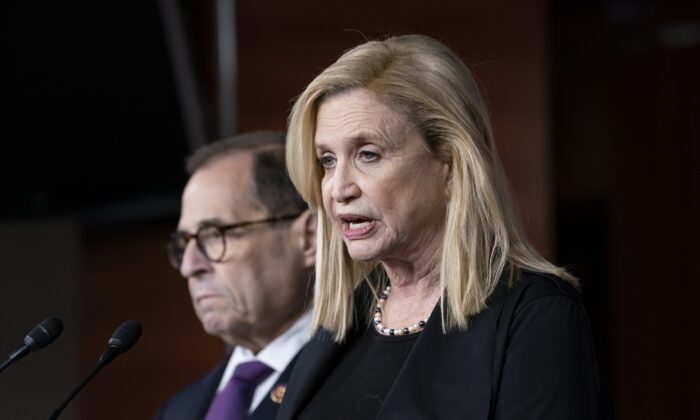
Fifteen Congressional incumbents lost preliminary contests during the recently-completed 2022 midterm primary cycle, nearly double those denied renominations in 2020 primaries and the highest number of sitting reps ousted by party rivals since the 1980s.
The 15 defeated incumbents—nine Republicans, six Democrats—top the 14 sitting House reps unseated in 1992 primaries that presaged 1994’s midterm conservative capture of the House under Speaker Newt Gingrich (R-Ga.) and the 13 booted from office in 2012’s primaries when Tea Party activists rattled the GOP.
But the fact that more incumbents lost preliminary nomination races in 2022 than, perhaps, in 40 years, is not evidence of an emerging anti-incumbent trend but confirmation that sitting Congressional reps and Senators rarely lose reelection bids.
U.S. House and Senate incumbents have a 90-percent plus reelection rate, including 94.72 percent in this year’s primaries, according to analyses by OpenSecrets.org.
House incumbents were reelected at a 94.7 percent clip in 2020, 91 percent in 2018, 96.7 percent in 2016, 95.4 in 2014, 89.8 in 2012, and 85.4 percent in 2010, OpenSecrets.org reports with 1970’s 85 percent being the chamber’s lowest incumbent reelection rate in the last 50 or so years.
Senate incumbents were reelected at an 83.9 rate in 2020, 84.4 percent clip in 2018, and 93.1 percent in 2016 with the chamber’s lowest reelection rate in recent history of 55 percent occurring in 1980 when Republicans flipped 12 seats to gain control of the Senate for the first time since 1955, documents OpenSecrets.org.
All 435 U.S. House seats and 34 U.S. Senate seats—20 held by Republicans, 14 by Democrats—are on the Nov. 8 ballot. Democrats have a 221-212 advantage in the House with Republicans favored to flip at least five seats to gain control of the chamber. The Senate is split and both parties believe they can win a majority in fall’s general election.
Candidate Numbers
According to analyses by the Brookings Institute’s Primaries Project and elections analytic site FiveThirtyEight, when the 2022 midterm cycle began in Texas in March, 2,362 people had filed to run as candidates in 600-plus U.S. House party primaries and 241 as candidates in 50-plus primaries for the 34 U.S. Senate seats,
After Delaware, Rhode Island, and New Hampshire voters cast their ballots in the last of 48 state 2022 primaries on Sept. 13, less than 1,100 of those 2,600-plus candidates are still campaigning.
According to FiveThirtyEight, there are now about 950 candidates from all parties seeking the 435 House seats and about 100 candidates running for the 34 U.S. Senate seats, including 34 Republicans, 33 Democrats, 20 Libertarians, and assorted third-party candidates.
In Senate primaries across the country, 91 Democrats ran in 23 party preliminaries and exactly 150 Republicans ran in 25 primaries. Nineteen of 31 incumbents running, including 10 Democrats, advanced without primary challenges.
Democrats are not running a candidate in Utah’s Senate race, but are supporting independent Evan McMullin’s campaign against incumbent Republican Sen. Mike Lee (R-Utah).
Three of 14 incumbent Democrat Senators—Sens. Mark Kelly (D-Ariz.), Raphael Warnock (D-Ga.), Catherine Cortez Masto (D-Nev.)—are engaged in “tossup” races against GOP challengers.
Three of the 20 Senate seats held by Republicans, including two being vacated by retiring Senators in Ohio and Pennsylvania, are up for grabs with incumbent Sen. Ron Johnson (R-Wisc.) the most endangered of the chamber’s sitting Republicans
While only 38 percent of incumbent Senators on November’s ballot faced primary tests, more than 64 percent of sitting House reps running for reelection had to win inter-party preliminaries to earn their general election berths, according to Brookings Institute’s Primaries Project.
More than 100 House incumbents advanced without a primary challenge, but 284 sitting reps were “primaried” with 15 failing to be renominated while nearly 95 percent won, often easily.
Census Redistricting
As in 2002 and 2012 when double-digit incumbents lost renomination races, the 2022 primaries followed post-2020 Census reapportionment that altered more than 360 of the House’s 435 districts.
Across the nation, post-2020 Census redistricting essentially baked in advantages for incumbents, making 94 percent U.S. House districts “safe” for one party or the other. The Cook Political Report only rates 31 House races as competitive.
Also as a result of redistricting, incumbents in six redrawn districts—eight Democrats and four Republicans—were pitted against each other, including two sets of incumbents in Illinois.
Among reps defeated in incumbent-on-incumbent primaries is Rep. Carolyn Maloney (D-N.Y.), who lost to Rep. Jerry Nadler (D-N.Y.)—both have more than 30 years’ experience in the House—and Rep. David McKinley (R-W.Va.), who lost to Trump-endorsed Rep. Alex Mooney (R-W.Va.).
Republican Enthusiasm
In sifting through the data accumulated from nearly 700 House and Senate primaries over the last seven months, Brookings Institute Primaries Project coordinator Elaine Kamarck, founding director of the Center for Effective Public Management, notes Republican enthusiasm entering the 2022 midterms is evident in the number of GOP candidates seeking federal office.
Of the 2,362 candidates who ran in congressional primaries across 48 states—82 more than ran in 2020—nearly 60 percent, or 1,397, were Republicans.
Using “candidate’s own self-identification” in assessing the political tenor of the nearly 1,400 GOP and 1,000 Democratic congressional candidates, the Brookings Institute analysis shows Republican voters electing more conservative candidates and Democratic voters preferring to place centrists on their ballots.
Kamarck in a Sept. 7 analysis said there is a trend in more incumbents being challenged in primaries by party rivals, but the fact that few succeed remains a constant.
Only 25 percent of Democratic Congressional reps and 20 percent of sitting Republican House members were challenged in 2004’s primaries. Since 2010, the ratio has been about 50 percent with 64 percent being tested this year, according to Brookings Institute.
“This trend is testament to the increasing polarization of our politics, the increasing strength of factions within each political party, and the realization that contesting primaries was a very cost-effective way of changing political parties,” Kamarck writes.